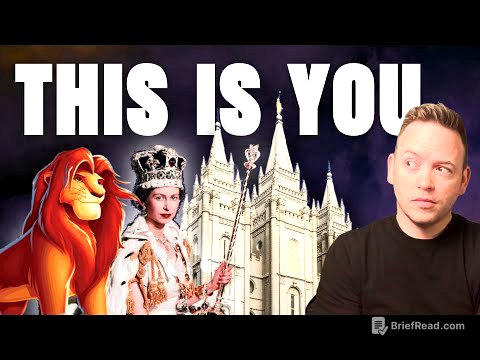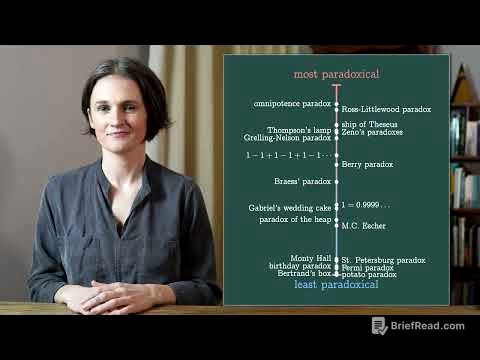TLDR;
This video explores the Book of Revelation, examining its historical context, authorship, and possible interpretations. It connects the book to older apocalyptic traditions, such as the Book of Daniel and the Epic of Erra, and discusses whether John's visions were divine prophecy, a psychedelic experience, or a coded message for persecuted Christians. The video also raises questions about recurring cycles of destruction and the potential return of ancient beings or forces.
- The Book of Revelation is a fusion of ancient apocalyptic traditions.
- Interpretations of Revelation range from coded messages to literal prophecies.
- Ancient texts like the Epic of Erra share similar apocalyptic themes.
- The video explores the possibility of psychedelic influences on John's visions.
- The cycle of destruction and rebirth is a recurring theme in ancient cultures.
Intro [0:00]
The Book of Revelation is a cryptic and chaotic vision of destruction, judgment, and rebirth that has been studied, feared, and misinterpreted for nearly 2,000 years. It is unlike any other book in the Bible, filled with beasts, plagues, and a final battle between good and evil. The book gave the world the Four Horsemen, the Antichrist, the number 666, and the promise of a New Jerusalem. It is a fusion of ancient apocalyptic traditions and a puzzle of hidden meanings, buried warnings, and desperate hope.
Jon of Patmos [2:40]
John of Patmos, the man who received the vision of the end of the world, was most likely a Jewish Christian prophet living in the late 1st century AD. He was on the desolate island of Patmos, either by exile or willingly seeking solitude, when he claimed to have received the visions recorded in the Book of Revelation. Some believe his writing was a coded message to persecuted Christians, while others see it as a true glimpse into the cosmic war between good and evil. It is speculated whether John's vision was a product of his mind unraveling in isolation or if he was a mystic who tapped into a deeper current of human consciousness.
The Day of Final Judgment [5:44]
John was lifted beyond the world and saw a throne surrounded by 24 elders, lightning, and creatures covered in eyes. He saw a scroll sealed seven times over, which only the Lamb could open. As the Lamb opened the seals, riders emerged on white, red, black, and pale horses, bringing conquest, war, famine, and death. A great dragon stood before a woman cloaked in the sun, and war erupted in heaven. Another beast rose from the sea, bearing the number 666, and Babylon the great harlot reveled in corruption before falling. Finally, a white horse appeared, its rider called faithful and true, and a new heaven and earth emerged.
The Book Of Revelation [9:36]
The earliest complete version of Revelation appears in the Codex Sinaiticus from the 4th century AD. By AD 180, Christian writers quoted from it, proving it was already well known. While widely accepted in Asia Minor, some churches rejected it as too mystical. Revelation borrowed from Jewish apocalyptic writings like the Book of Daniel and the Book of Enoch, as well as Greek and Roman influences. Some scholars see the Beast as a symbol for the Roman Empire. The Council of Carthage in AD 397 officially cemented Revelation into the New Testament.
Daniels Vision [12:43]
Daniel, a captive in Babylon, received visions of four beasts representing kingdoms that would rise and fall. John saw the same thing, but in Revelation, the beasts merge into one. Daniel spoke of a son of man who would come on the clouds, while John saw him riding a white horse. Daniel was given a sealed scroll, which John saw the Lamb take and break the Seven Seals. Both men saw the Resurrection, with the dead rising to eternal life or destruction. Daniel saw the outline of a prophecy, while John saw its completion.
Ancient Beasts [15:07]
The Book of Daniel describes four beasts rising from the sea, while John of Patmos saw a single entity with the body of a leopard, the feet of a bear, and the mouth of a lion. These beasts have been interpreted as symbols of empires or literal end-time rulers. Long before the Bible, the Babylonians carved visions of chimeric monstrosities, and in their creation myth, Tiamat gave birth to hybrid creatures. The Book of Enoch describes creatures born from corruption, created by fallen angels who experimented on animals.
The Epic of Erra [17:54]
In ancient Babylon, the Epic of Erra tells of a war god who brings destruction, plague, and fire. Erra needed permission to strike, so he manipulated Marduk, the chief god, leading to chaos. Erra had seven divine warriors who embodied different forces of destruction, spreading war, famine, and death, similar to the seven trumpets and bowls of wrath in Revelation. John's visions retell a destruction that had already happened when Erra ruled the world. Revelation describes a final kingdom given power by the dragon, suggesting a repeat of a cycle that began with the gods.
A Psychedelic Vision? [21:13]
Spiritual revelations and hallucinatory experiences have often been linked throughout history. Ancient prophets like John practiced fasting, isolation, and extreme prayer, which can trigger altered states of consciousness. Many cultures used psychoactive plants in religious ceremonies, and substances like ergot, datura, and Amanita muscaria mushrooms were known to cause powerful hallucinatory experiences. John's vision in Revelation shares similarities with known psychedelic experiences, such as hyperreal imagery, loss of time and space, encounters with supernatural beings, and a sense of ultimate truth.
The Return of The Anunnaki [24:17]
The Book of Revelation is a prophecy, a warning, and a mystery, potentially repeating itself in new forms. Beneath the symbols, it tells of a pattern: a cycle of rise and fall, kings and gods, creation and destruction. In moments of collapse, the gods return. These could be the Anunnaki, echoes of a past war, or monstrous rulers empowered in dark times. John may have seen the future, the past, or something beyond time, suggesting a cycle that has never truly stopped.









